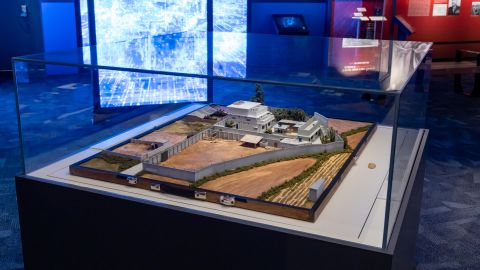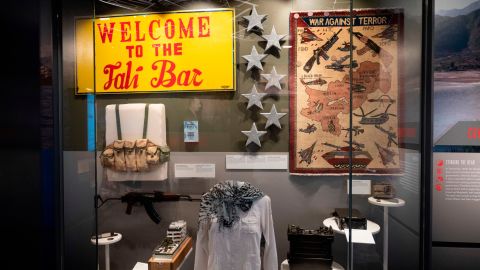Langley, Virginia CNN —
Not long after the United States killed one of the top 9/11 architects in Kabul earlier this year, CIA Director Bill Burns had a suggestion for the man in charge of the agency’s private museum of intelligence artifacts.
“Director Burns came to me … and said I’ve got one more item for your museum, do you have space?” recalled museum director Robert Byer. “And when he told me what it was, I said yes, we will make sure we have space.”
The item was the model used by Burns to brief President Joe Biden on the planned operation to take out Ayman al-Zawahiri, who was killed by a US drone strike on July 31. In White House photographs released after the strike, Burns can be seen talking to the President with a tantalizing box between them. Inside is the model, now declassified and on display at the agency’s museum, a perfect miniature of the three-story balconied compound topped with barbed wire and boasting a pair of tiny green trees in the courtyard.
The CIA’s museum, which isn’t open to the public, seeks to chronicle the agency’s 75 year history for officers and other invited guests, with exhibits spanning some of the CIA’s biggest successes and biggest failures. It features everything from an extensive collection of Cold War-era spy gadgets – tiny cameras and miniaturized copies of “The Gulag Archipelago” secreted into disguised canned goods – to more recent items like the covers for the binder and tablet used for Biden’s presidential daily brief.
The museum also houses the original model of the Abbottabad complex that President Obama studied to determine whether to greenlight the operation to kill Osama bin Laden in 2011.

“For most operations, having an ability to see everything in 3D really helps everyone out in terms of seeing the space, understanding how the operation can go,” Byer said. “This Zawahiri model is no different.”
The Zawahiri model is displayed alongside another new exhibit derived from America’s two-decade war in Afghanistan: seven stars representing seven CIA officers who were killed in a suicide bombing in Khost in 2009 – a bombing that took place during the hunt for Zawahiri. The CIA had invited a Jordanian doctor whom they believed had been turned against al Qaeda onto Forward Operating Base Chapman, only to have him detonate a suicide vest once inside the perimeter of the base.
The stars, until the US withdrawal from Afghanistan last year, had been part of a memorial at Khost.

“I’m very honored to have not only those stars in the collection, but having the Zawahiri compound truly closes the loop for CIA, and we’re very honored to have that in the collection,” Byer said.
Another new exhibit contains artifacts from the famous CIA mission known as Project Azorian, exposed by the Los Angeles Times in 1975. Billionaire Howard Hughes had provided the cover for the mission, claiming that his massive ship, the Glomar Explorer, was mining manganese nodules from the sea bottom. But in reality, the ship housed a gigantic claw that was lowered through a secret chamber in the hull of the ship to retrieve a Soviet submarine that had sunk in the Pacific in 1968. Part of the submarine slipped loose and was lost in the recovery, but the claw managed to hold onto some of its valuable prize.
“What’s amazing about this cover story is that it definitely was a good one. How do we know that? There was a boom in deep sea mining once Howard Hughes announced that he was going to mine ocean floor for manganese nodules,” Byer said.
The museum now displays a 3D model of the sunken K-129 submarine used as part of operational planning, a manganese nodule excavated from the ocean floor as part of the cover story, and a wig worn by the CIA deputy director to secretly visit the Glomar Explorer and manage the true mission.

The items at the agency’s museum are unclassified, and Byer said officials are working to get all of its artifacts published online at CIA.gov. But the museum lives at Langley, where the public can’t access it directly, for a reason: it is primarily intended for CIA officers, so that they can learn the agency’s history. It also has an “operational” aspect, Byer said: educating foreign partners about what the CIA has done and “cement partnerships on a deeper level.”
Tantalizingly, Byer says there are many more potential exhibits that are still classified.
“We look for the artifacts that have the greatest impact on CIA history,” he said. “The declassification process is something that usually is affected by… how much how many years have gone by, and so, hopefully, we’re able to declassify a big portion of material when it hits a 25 or 50 year mark of a project.”


